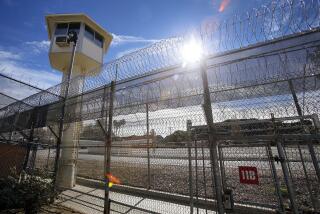Baca Holds Community Meeting to Address Violence at Pitchess
Increased supervision. More Mexican food. Better vocational training. A sweat lodge for inmates to purify themselves.
These were some of the ideas proposed Monday at a community meeting held to address the racial tensions and ongoing violence at the sprawling Pitchess Detention Center near Castaic.
It was the first event of its kind, said Los Angeles County Sheriff Lee Baca, and it represented a new approach to solving problems behind bars. By soliciting input from community leaders, Baca and his top brass hope to develop alternative programs and tactics to defuse tensions within the jail system and make it safer.
There were preachers, child advocates, outspoken activists, worried moms and former inmates at the meeting--around 40 of them, along with two dozen law enforcement officials, including Baca.
“We don’t have the crystal ball,” Baca told the group. “But we’re here to accept any idea that’s worth a try, and I have the power to try it.”
After listening to the audience, sheriff’s officials unveiled several proposals of their own. The most dramatic was moving inmates less than 35 years old and those facing murder charges out of dorm-style housing units and into smaller cells.
These are the most potentially troublesome inmates, said Cmdr. Steve Day, head of the Pitchess compound, and dorms are the most problematic setting. Over the weekend, 355 such inmates were transferred.
Officials also plan to increase jail programs such as reading classes and vocational training, because “busy inmates don’t fight,” Day said. Other ideas included inviting more clergy into the jail, revisiting the inmate classification system and working with human relations specialists to develop a diversity-training video for inmates to watch on the TVs in their dorms or cells.
Last month, hundreds of inmates were involved in brawls between black and Latino prisoners at the 10,000-inmate jail. Several dozen men, mostly black, were seriously injured, and fighting between the groups has continued through last week. Most of the fighting occurred in dorms, where as many as 120 inmates are kept in one room.
Authorities took the unusual step last month of segregating inmates by race and have met some violent resistance trying to re-integrate them.
Many community leaders have complained that the Sheriff’s Department hasn’t done enough to prevent the violence. On Monday several said they appreciated the dialogue and the ideas.
“It’s a good start,” said Connie Watson, a South-Central family advocate. “The key is whether they will follow up.”
And as sheriff’s officials promised, no idea was dismissed. Not even the sweat lodge. Jamie Gutierrez, a beret-wearing activist who monitors police conduct, said the Native American therapy helped purify the mind and the soul and would relax violent inmates.
“Who knows?” said Assistant Sheriff Dennis Dahlman after the meeting. “I’ve heard about sweat lodges at other facilities, and if it works, maybe it’s something we’ll look into.”
More to Read
Sign up for Essential California
The most important California stories and recommendations in your inbox every morning.
You may occasionally receive promotional content from the Los Angeles Times.










